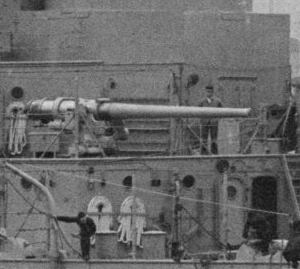| 5"/51 caliber gun | |
|---|---|
 5"/51 caliber Mark 8 gun on starboard forecastle of USS Texas, March 1914 | |
| Type | |
| Place of origin | United States |
| Service history | |
| In service | 1911–c. 1947 |
| Used by | |
| Wars | |
| Production history | |
| Designer | Bureau of Ordnance |
| Designed | 1910 |
| Manufacturer |
|
| No. built |
|
| Variants | Marks 7, 8, 9, 14, 15 |
| Specifications | |
| Mass |
|
| Length | 261.25 in (6,636 mm) |
| Barrel length | 255 in (6,500 mm) bore (51 calibers) |
| Shell | 50–55.18 lb (22.68–25.03 kg) |
| Caliber | 5 in (127 mm) |
| Breech | side swing Welin-type |
| Elevation |
|
| Traverse | up to 360° depending on location |
| Rate of fire | 8-9 rounds per minute |
| Muzzle velocity |
|
| Effective firing range | 17,000 yd (16,000 m) at 20° elevation |
| Maximum firing range | 20,142 yd (18,418 m) at 45° elevation (World War II ammunition) |
5"/51 caliber guns (spoken "five-inch-fifty-one-caliber") initially served as the secondary battery of United States Navy battleships built from 1907 through the 1920s, also serving on other vessels. United States naval gun terminology indicates the gun fired a projectile 5-inch (127 mm) in diameter, and the barrel was 51 calibers long.[1]
- ^ Fairfield 1921 p. 156